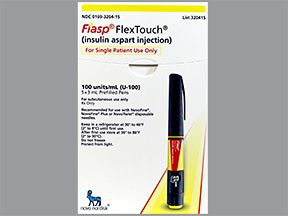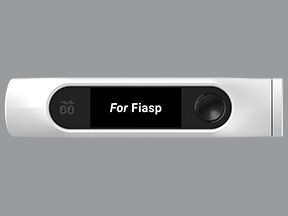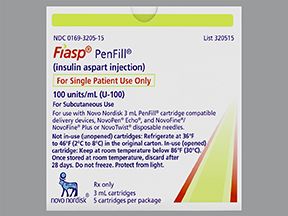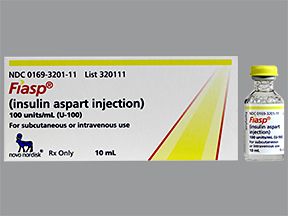If you have certain types of diabetes, your doctor might suggest Fiasp as a treatment option for you. It’s a prescription drug used to control blood sugar levels in:
- adults and children with type 1 diabetes
- adults and children with type 2 diabetes
The active ingredient in Fiasp is insulin aspart. (An active ingredient is what makes a drug work.)
You’ll inject Fiasp under your skin. The drug is available in three forms:
- liquid solution in a multidose vial
- FlexTouch pen
- PenFill cartridge, which is used with certain refillable insulin pens
This article describes the dosages of Fiasp, as well as its strength and how to use it. To learn more about Fiasp, see this in-depth article.
Note: This article covers Fiasp’s usual dosages, which are provided by the drug’s manufacturer. But when using Fiasp, always use the dosage your doctor prescribes.
Fiasp is given as an injection under the skin.
When you first start Fiasp treatment, your doctor or pharmacist will show you how to give yourself injections. Then you’ll give yourself injections at home.
What are the forms of Fiasp?
Fiasp comes in three forms:
- liquid solution inside a multidose vial
- FlexTouch pen
- PenFill cartridge, which is used with certain refillable insulin pens
What strength does Fiasp come in?
Fiasp comes in one strength: 100 units per milliliter.
What are the usual dosages of Fiasp?
Typically, your doctor will start your treatment with a low dosage. Then they’ll adjust it over time to reach the amount that’s right for you. Your doctor will ultimately prescribe the smallest dosage that provides the desired effect.
Your doctor may adjust your dosage to best fit your diabetes care plan. Factors that can affect the dosage you’re prescribed can include:
- your diet
- your level of physical activity
- other medical conditions you have
- other drugs you take
Your doctor may need to adjust your dosage over time. In some cases, they may recommend a correction dose. (A correction dose is an extra dose to help decrease your blood sugar if it reaches a certain level.)
You may also get a chart from your doctor to help you keep track of your insulin dosages. This chart will also show you when you’d need to take a correction dose. To learn more about the Fiasp dosage that’s right for you, talk with your doctor.
Dosage for type 1 diabetes
If you have type 1 diabetes, the total insulin dosage you’ll take throughout the day is based on your body weight in kilograms (kg).*
Most people typically take 0.4 to 1 unit of insulin per kg of body weight per day. So, for example, if you weigh 50 kg (about 110 lbs.), your total daily insulin dose will likely be 20 units to 50 units.
Your total daily dose will likely consist of two types of insulin: rapid-acting insulin and long-acting insulin. Rapid-acting insulin, such as Fiasp, helps manage your blood sugar after a meal. On the other hand, long-acting insulin is released over time into your bloodstream.
Your doctor will determine how much of your daily dose will come from Fiasp and how much will come from a long-acting insulin.
* One kg is about 2.2 pounds (lbs.).
Dosage for type 2 diabetes
If you have type 2 diabetes, the total insulin dosage you’ll take throughout the day is based on your body weight in kilograms.
A common total daily insulin dose for people with type 2 diabetes is 0.3 to 0.5 units of insulin per kilogram of body weight. For example, if you weigh 50 kg (about 110 lbs.), your total daily dose will likely be 15 units to 25 units.
Your total daily dose will likely consist of two types of insulin: rapid-acting insulin and long-acting insulin. Rapid-acting insulin, such as Fiasp, helps manage your blood sugar after you eat a meal. And long-acting insulin is released over time into your bloodstream.
Your doctor will determine how much of your daily dose will come from Fiasp and how much will come from long-acting insulin.
What’s the dosage of Fiasp for children?
Fiasp is approved to treat type 1 or type 2 diabetes in children.
The dosage of Fiasp in children with diabetes is the same as the dosage in adults. (For additional information, see “Dosage for type 1 diabetes” or “Dosage for type 2 diabetes” just above.)
Your child’s dosage and diabetes care plan may depend on many factors, including body weight, type of diabetes, activity level, diet, and other medications they’re taking.
Your child’s doctor will help determine the best dosage of Fiasp for your child. If you have questions or concerns about your child’s dosage of Fiasp, talk with their doctor.
Fiasp used long term?
Yes, Fiasp is usually used as a long-term treatment. If you and your doctor determine that it’s safe and effective for your condition, you’ll likely use it long term.
Below are answers to some commonly asked questions about Fiasp’s dosage.
How long does Fiasp last in the body?
Fiasp is a rapid-acting insulin. This means it lasts for a short time in your body (typically a few hours). Insulins such as Fiasp are also sometimes called “mealtime insulins” because they help manage your blood sugar after a meal.
How fast does Fiasp work?
Fiasp starts working right away to help manage your blood sugar levels after a meal. That’s why it’s important to use Fiasp at the start of your meal or within 20 minutes of when you begin eating.
The dosage of Fiasp you’re prescribed may depend on several factors. These include:
- the type and severity of the condition you’re using Fiasp to treat
- your age
- the form of Fiasp you’re using
- other medications you take
- other medical conditions you have
- your body weight
- your diet
- your exercise routine
- other conditions you may have
You should take Fiasp according to the instructions your doctor gives you.
You’ll inject Fiasp under your skin. The drug is available in three forms:
- liquid solution in a multidose vial
- FlexTouch pen
- PenFill cartridge, which is used with certain refillable insulin pens
You’ll typically inject your dose of Fiasp at the start of your meal or within 20 minutes after you start eating a meal.
Before you start your Fiasp treatment, your doctor or pharmacist will show you how to inject the medication. It can be injected into your upper arm, belly, buttocks, or upper thigh. (If you want to inject the drug into your upper arm, you’ll likely need a caregiver or someone else to help you.)
You should not inject Fiasp into any areas that are bruised, damaged, or scarred. You should also rotate your injection sites with each dose of Fiasp. This will help lower your risk of skin irritation at your injection sites.
The drugmaker provides step-by-step instructions on how to use the different forms of Fiasp.
For information on the expiration, storage, and disposal of Fiasp, see this article.
Accessible drug containers and labels
If you find it hard to read the prescription label on your medication, tell your doctor or pharmacist. Some pharmacies provide medication labels that:
- have large print or use braille
- feature a code you can scan with a smartphone to change the text to audio
Your doctor or pharmacist may be able to recommend pharmacies that offer these accessibility features if your current pharmacy doesn’t.
You’ll typically inject your dose of Fiasp at the start of your meal or within 20 minutes after starting your meal.
Your doctor will likely recommend that if you forget to take your dose of Fiasp at mealtime, you should monitor your blood sugar levels. If they become too high, you may need to inject a dose of Fiasp. If they’re not too high, you’ll likely skip the missed dose and take your regular dose of Fiasp at your next meal.
If you miss your dose of Fiasp and aren’t sure when to take your next dose, ask your doctor or pharmacist.
If you need help remembering to inject your dose of Fiasp on time, try using a medication reminder. This can include setting an alarm or downloading a reminder app on your phone.
Do not use more Fiasp than your doctor prescribes, as this can lead to serious side effects.
Symptoms of overdose
An overdose of Fiasp can cause low potassium levels or low blood sugar. These conditions can be life threatening.
Symptoms of low potassium levels or low blood sugar can include:
What to do in case you use too much Fiasp
Call your doctor right away if you think you’ve injected too much Fiasp. You can also call 800-222-1222 to reach the American Association of Poison Control Centers or use its online resource. But if you have severe symptoms, immediately call 911 (or your local emergency number) or go to the nearest emergency room.
The sections above describe the usual dosages provided by the drug’s manufacturer. If your doctor recommends Fiasp for you, they’ll prescribe the dosage that’s right for you.
Remember, you should not change your dosage of Fiasp without your doctor’s recommendation. Only use Fiasp exactly as prescribed. Talk with your doctor if you have questions or concerns about your current dosage.
Here are some examples of questions you may want to ask your doctor:
- Should my dosage change if Fiasp isn’t working well enough for me?
- Would a different dosage raise or lower my risk of side effects from Fiasp?
- Does my dosage of Fiasp need to change if I’m taking other drugs along with it?
- Are there other insulins that work longer than Fiasp does?
To get information on different conditions and tips for improving your health, subscribe to any of Healthline’s newsletters. Or to connect with others who have your condition, join a Bezzy community.
Disclaimer: Healthline has made every effort to make certain that all information is factually correct, comprehensive, and up to date. However, this article should not be used as a substitute for the knowledge and expertise of a licensed healthcare professional. You should always consult your doctor or another healthcare professional before taking any medication. The drug information contained herein is subject to change and is not intended to cover all possible uses, directions, precautions, warnings, drug interactions, allergic reactions, or adverse effects. The absence of warnings or other information for a given drug does not indicate that the drug or drug combination is safe, effective, or appropriate for all patients or all specific uses.




